Gamera Super Monster, Gamera The Giant Monster, Gamera Vs. Barugon, Gamera Vs. Guiron, Gamera Vs. Gyaos, Gamera Vs. Jiger, Gamera Vs. Viras, Gamera Vs. Zigra (1965, 1966, 1967, 1968, 1969, 1970, 1971, 1980)
Directed by: Noriaki Yuasa, Shigeo Tanaka
Written by: Niisan Takahashi
Starring: Carl Craig, Eiji Funakoshi, Eiko Yanami, Kojiro Hondo, Ktoyo Enami, Mach Fumiake, Nobuhiro Kajima, Tsotomu Takakuwa
GAMERA: THE COMPLETE COLLECTION
ON BLU-RAY 17TH AUGUST from ARROW VIDEO
PART ONE: DISCS ONE TO FOUR – THE SHOWA FILMS
REVIEWED BY: Dr Lenera
Long time readers of this website will know of my love for Godzilla and friends, from my detailed reviews of each film to my write-up of Criterion’s box set [or rather ‘book set’] release of the first fifteen entries in the franchise to my posting of any news concerning ‘The Big G’. However, Godzilla and Toho Studios didn’t quite have the field to themselves. A few other studios tried their hand at this kind of thing, hoping that creatures such as Guilala and Gappa [The Triphibian Monster] would become popular enough to start a rival series, but it was only Gamera from Daiei Studios [later to be Kadokawa Daiei Studios] who succeeded in this. What is Gamera? Gamera is a giant, fire-breathing, flying jet-propelled turtle who, much like Godzilla, wrecks cities and battles other creatures as is the kaiju movie tradition. He never quite attained Godzilla’s popularity, but the franchise still lasted many decades. I’ve wanted to delve into it for several years now, but have never found the time. I haven’t even seen all of the films, and the ones that I have I haven’t done so for a very long time. However, Arrow are bringing out this quite amazing box set containing every single Gamera movie, and have been kind enough to send screeners, so it was now time for me to explore loads more crazy Japanese monster action – plus plenty of special features.
DISC ONE:
GAMERA THE GIANT MONSTER [1965] aka DAIKAIJU GAMERA [GIANT MONSTER GAMERA], GAMMERA THE INVINCIBLE
RUNNING TIME: 78 mins
In the Arctic, an American jet fighter shoots down a Japanese plane containing an atomic bomb. The resulting explosion and cataclysm awakens a huge prehistoric turtle called, according to a local Inuit chief, Gamera. The creature heads for Japan and starts to wreck cities while government officials and scientists including Doctors Hidaka, Kyoko and Aoyagi try to work out how to rid the world of this creature, who may be causing mass destruction but who, curiously, also befriends a small boy named Toshio….
1954’s Godzilla took a while to show its star, but Gamera’s debut movie doesn’t waste any time at all. After five minutes of terribly acted US Air Force personnel wearing Army outfits which hardly gets things off to a good start, the big turtle comes out of the ground and we get lots of close-ups of various parts of Gamera [nothing rude though] continuing under the titles. Unlike every other turtle though, Gamera doesn’t like to walk on four legs, Daiei deciding to make it easier for the guy [or guys – apparently they went through a suit performer nearly every day while making this film because the job was so physically demanding] wearing the suit by only requiring him to walk upright for most of the time. Even Toho tended to show their four legged creatures actually moving on all fours, while generally avoiding shots of the back legs and the suit performer being on his knees. And then, about half way through, Gamera [who’s a turtle remember] pulls his head, limbs and tail into its shell, emits flames from its front leg and back leg cavities, and flies off by rising up into the air and spinning around like a flying saucer! By now it was 1965 and audiences would have seen Godzilla engaged in monster talk with fellow titans Rodan and Mothra, and Godzilla doing a victory jig on Planet X, but it’s still a classic crazy kaiju moment. And they really do try to make Gamera seem lethal. As a scientist says, “cellular tissues of Gamera’s body must be so dense that they are more resilient than our strongest alloys. Also, it has the ability to consume inorganic matter and then process it into organic matter”. He even breathes what is obviously real fire on screen! How ‘hard’ is that? Killing him seems impossible, but maybe removing him might be achievable?
Seeing as by now people were used to seeing their Japanese monsters in colour, one wonders why Daiei opted to make Gamera The Giant Monster in black and white, unless it was to deliberately recall Godzilla. The two films do have obvious parallels. Gamera is also awoken by atomic bombs [though we never do learn of the origin of the crashed plane that releases him] and proceeds to stomp and smash, and some of his first film, which is also largely set at night, does have some of the sombre documentary feel of Godzilla. There’s even a bit of anti-nuclear, as well as environmental, messaging, though the allegorical element of the Toho film is of course not present. Still, Gamera gets a good Tokyo workout even if it can’t compare with Godzilla’s. However, set against the serious side of the tail is the subplot of the lonely little boy who feels an attachment to Gamera. He has a pet turtle called Pee-Wee whom he takes to school, thinks that Pee-Wee grew into Gamera, collects rocks to, “build a home for Gamera“, and says things like, “Gamera doesn’t mean to be bad”, “He’s a gentle animal”. Try telling that to the thousands of people Gamera’s killing right now [we even see his fiery breath torching a group], mate. It makes little sense, and gives the film a slightly schizophrenic feel, but it’s interesting to see how Daiei were already directly trying to make Gamera appeal to kids and give their series its own, distinct personality.
Of course you have to chuckle at things like it being thought up that freezing Gamera might be a good thing, and conveniently the military are working on a freezing weapon right now. And the three main [adult] human characters – the scientist, his pretty assistant, and reporter who fancies the latter – make little impression, even if the acting is fine. But the model work is fairly detailed and the special effects by Yonesaburo Tsukiji really are pretty good, if usually lacking the complexity which Toho’s Eiji Tsuburaya would often attempt. This was largely due to Tsukiji having a considerably smaller budget to work with, though there is one really impressive shot of Gamera approaching a building and through one of the windows you can see lots of people running in panic inside; the matching is almost seamless. And the matte paintings are superb. Director Noriaka Yuasa, who would go on to helm all eight movies in the first Gamera series which would end in 1980 [some would say 1971, I’ll get on to this in time], doesn’t yet bring much personality to the proceedings, while Tadashi Yamanouchi’s music is just adequate. Nonetheless, the very brisk 78 minutes which is Gamera The Giant Monster still make for a real fun watch, even if the real madness that would come to characterise this soon-to-be totally barmy series is only very occasionally present.
Rating: 









SPECIAL FEATURES
High Definition (1080p) transfer of Gamera the Giant Monster, with lossless original Japanese and dubbed English mono audio, and optional English subtitles
Arrow are probably using Scream Factory’s restorations for all of the Gamera films. Based on what we have here in terms of Gamera The Giant Monster, we’re in for a treat in terms of picture quality. Some of this film has an almost noir-ish look to it which the transfer handles excellently, with blacks exhibiting no crush. It’s all pretty sharp and detailed. Of course we can now see some wires, and a few shots of stock footage are very obvious, but that’s only to be expected. The English dubbed version is pretty bad. All the Showa films except for the last one were re-released to American TV in the ’80s, using complete prints but with awful dubbing far inferior to the original American dubs, by producer Sandy Frank.
Audio Commentary by Japanese cinema expert August Ragone
I decided to play Ragone’s introduction to the film before his audio commentary which was on the Scream Factory release, though for first time viewers I’d recommend watching the introduction and then the film before moving on to his full length talk track. He goes into greater detail about the things he mentions in his introduction, but, in addition to expressing several times his dislike for Toshio, also provides a hell of a lot of information about virtually all aspects of Gamera The Giant Monster. He obviously has access to the script, so he’s able to describe when scenes were cut [we could have had a dream sequence with Gamera and Toshio], as well as tell us things such as there being 23 partial or complete Gamera suits, something which might not be too obvious as Daiei were obviously better than Toho at making them match! There are some brief biographies but they’re just a small part of a very packed track. Let’s hope the successive commentaries are as good.
Introduction by Japanese cinema expert August Ragone [13 mins]
Best watched before the film, Ragone, who saw it at the cinema when he was in primary school, gives a potted history of the film, packing lots into just 13 mins. We learn that its origins lie in a giant rat movie that was aborted due to trouble with the real rats used on set, that there are conflicting stories as to how the concept originated, and plenty of other interesting facts.
High Definition (1080p) transfer of Gammera the Invincible (Blu-ray premiere), the American theatrical version of the film, with lossless mono audio and optional English subtitles for the deaf and hard-of-hearing [85 mins]
This is one of the better ‘Americanisations’ of a kaiju movie. The re-shot opening sequence benefits from having some reasonable acting, and there’s a pretty funny [intentionally] scene where three men on TV discuss whether or not a giant turtle can actually exist. And there’s less of Toshio which will probably please some. But the several scenes of Brian Donlevy and Albert Dekker as US military generals at meetings get rather dull, interrupt the flow of the movie and slow its pace. A pop song with just two words – “Gamera, Gamera” is heard at the beginning and at the end.
Remembering the Gamera Series, an archive featurette from 1991, including interviews with director Noriaki Yuasa, writer Nisan Takahashi and others [23 mins]
Luminaries involved with the first series of Gamera films look back, with emphasis on the first movie before covering the others in a more general fashion, meaning that this is a perfect watch for a Gamera virgin; it offers tasty glimpses of the sequels but doesn’t go into detail about them. Some of the information you’ll have already heard, but you get a greater description of what happened when they tried to create a snowy landscape from ice, and get to see a recreation, via paintings, models and toys, of some of Gamera Vs. Garasharp, which would have followed Gamera Vs Zigra had Daiei not filed for bankruptcy. This was also on the Scream Factory release.
Interview with Noriaki Yuasa, filmed by Jörg Buttgereit in 2002 [13 mins]
The second [the first being the introduction] of three featurettes not on the Scream Factory. Short and sweet, we have a Japanese woman translating Buttgeriet’s questions for Yuasa, who as usual seems happy to talk about Gamera. I’m not sure I’d agree with Yuasa when he says how Gamera is different to Godzilla because he usually walks on all fours; he very rarely walks on all fours it seems to me. But he says some interesting things, such as the messages in the films, and how East and West tend to think of monsters differently.
Gamera Special, an hour-long best-of compilation supervised by Noriaki Yuasa in 1991 [58 mins]
Also probably new to most western viewers, this was released on video in Japan. It’s basically a lengthy highlights reel, which means that, if you’re new to these, it’s probably best viewed when you’ve seen all the other films. We also get some trailers and a look inside the studio where we see a Gamera suit performer having his suit put on. This last bit is gold dust in my opinion and the kaiju lover in me was grinning from ear to ear!
Alternate English credits [5 mins]
The Sandy Frank releases of these films always had new opening and closing credit sequences over water. This is the one for Gamera The Giant Monster.
Trailers [5 mins]
U.S. Theme Song [4 mins]
Image gallery [12 mins]
DISC TWO:
GAMERA VS. BARUGON [1966] AKA DAIKAIJU KETTO: GAMERA TAI BARUGON [GREAT MONSTER DUEL: GAMERA VS. BARUGON], WAR OF THE MONSTERS
RUNNING TIME: 100 mins
Gamera is freed when a meteorite collides with the rocket transporting him to Mars. Meanwhile three mercenaries are sent by World War 2 veteran Kano to a South Pacific island to retrieve a huge opal he once found and hid in a cave. Kawajiri dies from a scorpion sting while Keisuke is betrayed by Onodera and killed in a cave-in. But en route back to Japan, the opal, actually an egg, is exposed to an infrared light by Onodera and out hatches Barugon, a lizard who grows to enormous size very quickly, though it seems that Japan isn’t big enough for two city-smashing titans….
I suppose I ought to begin this review by stating that the Barugon in Gamera Vs Barugon is not the similarly named creature in the previous year’s Toho outing Frankenstein Vs. Baragon, better known in the West as Frankenstein Conquers The World. That creature may have had a few similarities in terms of appearance, but it certainly wasn’t able to emit a very long but very thin tongue from his mouth that can fire a freezing substance, nor produce from its back a friggin rainbow [you should know by now that I’m not making any of this up] that sets fire to things. Nor was it said anywhere that one of these monsters is hatched every 8000 years. Sadly the suit of the monstrous chameleon variation looks rather rushed in design and you can easily see the suit performer crawling on his knees, even though this first sequel had a much bigger budget than Gamera The Giant Monster which was not expected to be the big box office hit in Japan that it became. And, unfortunately, there’s so much emphasis on Barugon, and trying to find various ways to destroy him, that Gamera, who’s now firmly on the side of good with no explanation [it took Godzilla five films to join the side of the angels and even after that he sometimes lapsed into his bad old ways], is given short shrift, only appearing in three short-ish sequences, though he appears on all fours more often than in any other Gamera film, and is given a slightly [I say slightly] more menacing look.
Still, the second Gamera film, one that is very different to the first despite having the same screenwriter [Niisan Takahashi] is probably [I haven’t done my usual research on these titles for lack of time] a popular one among kaiju fans, because it’s the only one of the Showa Gamera series to not feature a young child as a lead character. I personally don’t mind having youthful protagonists, but many do. In fact Gamera Vs. Barugon is the most serious of the first eight films, and is the one that most looks and feels like a Toho production from around the same time, though even they were getting goofy and even Mothra Vs. Godzilla had a few intentional chuckles, while this film handles its plot seemingly without the need for deliberate laughs at all. While it opens with some brief Gamera action, it then does what most of the Tohos of the time did and spend the next half an hour setting things up. The human side of things is interesting right away because this World War 2 soldier sending his nephew and two others to retrieve the opal he once hid is only doing this because he wants to be rich, then soon after we follow the villainous Onodera who takes it for himself, and Keisuke who survives Onodera’s murder attempt and heads back to Japan with native girl Karen [honestly], who brings a certain diamond which may just aid them against Gamera. Koji Fujiyama is good is Onodera, surely one of the nastiest kaiju movie characters; in one scene he not only beats up a crippled man but slams a chair on the man’s wife!. He was also in the first film and, much like in the Godzilla pictures, the same faces pop up in film after film.
This time Yuasa was relegated to just doing the special effects while Shigeo Tanaka was asked to direct, but they’re pretty good, showcasing the obviously bigger budget given to this entry. Hell, the matte paintings are better than Toho’s which usually look a bit ragged. After the first third the action keeps on coming, though a section involving Barugon following the diamond goes on for a bit longer than it needed to; yet by comparison the two fights are rather brief and the second one reminded me of your typical Steven Seagal end showdown which would mostly consist of Seagal beating the hell out of his opponent who’d barely get a chance to do anything back. Gamera has blue blood and Barugon has purple blood, both of which we see a fair bit of, though some of the successive Gamera films would go even further in this direction with some surprising gore on offer that outdoes what you sometimes see in ’70s Godzilla films. And we’re told that, “when an animal is hurt by a mistake, it never makes the same mistake again”. Okay then. Gamera Vs Barugon never quite kicks into top grade kaiju spectacle, and feels a tad stretched out, but provides much entertainment anyway, as well as having a theme of human greed which both adults and kids can surely understand.
Rating: 









SPECIAL FEATURES
High Definition (1080p) transfer of Gamera Vs.Barugon, with lossless original Japanese and dubbed English mono audio, and optional English subtitles
We have another very fine transfer here, with just the right level of grain and very fine colour, while the many night time sequences, which probably looked lousy on TV and video, are very well handled with fine density.
Audio Commentary by Japanese cinema expert August Ragone and Jason Varney
Ragone is joined by another kaiju expert, Jason Varney. While it’s hard to tell that the two are together at first with each trying to cram in as much information as possible, they do soon interact and often jokingly. Again, Ragone obviously has access to the original script as he points out many changes. We also hear how many series actors didn’t want to do these films and looked down upon them but became happy when their popularity endured, how Barugon’s sound came from the aborted giant rat movie that became Gamera The Giant Monster, and much other goodness. I should warn you that there’s a lot of time devoted to biographies [my major audio commentary irritation], in fact virtually everyone in the film is given one. But it’s only one flaw and not everyone will find this as bothersome as I do.
Introduction by Japanese cinema expert August Ragone [8 min]
Best heard before you watch the film if this is your first time, Ragone gives a potted history of the film’s production, including its origins as Gamera Vs. The Ice Giants, and how it was a really prestige production but its adult approach didn’t lead to box office success leading to Yuasa being asked to return as director.
High Definition (1080p) transfer of War of the Monsters, the shorter American edit of Gamera vs. Barugon, with lossless English audio
For some reason Toho only allowed Criterion to include two of the alternate American cuts of the films in the Showa Godzilla set and only two of the original American dubs – and it seems that Kadogawa Pictures, who now own Gamera, did a similar thing with Arrow, for whatever reason. After listening to the dub on this American edit of Gamera Vs. Barugon, the ’80s ones on the following movies seem very poor by comparison. Oh well. The War Of The Monsters cut of Gamera Vs. Barugon is eleven minutes shorter, and some might say better. The film has been tightened by losing some dialogue in many scenes, most notably in the final third involving plans to get rid of Barugon. However, a small portion of monster fight footage has also been deleted for some reason.
Alternate English Credits [3 mins]
Theatrical Trailers [6 mins]
Image Gallery [21 mins]
GAMERA VS. GYAOS [1967] AKA DAIKAIJU KUNHUSEN: GAMERA TAI GYAOS [GIANT MONSTER MIDAIR BATTLE: GAMERA VS. GYAOS, GAMERA VS. GAOS, RETURN OF THE GIANT MONSTERS
RUNNING TIME: 86 mins
A series of volcanoes erupt in Japan, one of them Mt. Fujiko, into which climbs Gamera, something seen by a small boy named Eiichi. Nearby, Chuo Expressway Corporation is building a roadway nearby, but local villagers refuse to leave; their protests though are a ploy to get more money for the land. Mysterious deaths and incidents of destruction in the area point not to Gamera, but a bat-like creature named Gyaos who hates the sun. Eiichi becomes trapped in a cave, but Gamera has something of a fondness for children, while Dr. Aoki and the Countermeasures Group are thinking of how to get rid of Gyaos….
The first Gamera film was mostly testing the waters even if it also made steps in the direction of where its makers wanted the series to go. The second one more closely imitated Toho and lacked a fresh approach even if it was a slightly better film. And the third one is a sort of midway step between its two predecessors and the remaining five entries in the Showa Gamera series, though it does do one thing that no other movie in the first eight did; make one of its monsters reasonably scary. Obviously the idea of a monster that can only come out at night has obvious potential in that respect, but, even though his head looks more metallic than flesh and his body is as big as his wings, he actually looks evil, makes a horrible screeching noise [though I wouldn’t say that it sounds like the word “Gyaos” which is what its youthful hero says and why he names him that], and has a taste for blood – in fact he has several characteristics that vampires also have. There’s a scene where we see him poised over a wrecked train, leering down hungrily upon a crowd of fleeing people, in a shot that is not just perfectly integrated, but is also rather unnerving. This time the weapons are wings that make wind storms a la Rodan, gas that comes out of his chest, and a ray that slices up everything, including almost severing one of poor Gamera’s arms in the grisliest moment yet for the series. Gamera himself now has goofier eyes; understandably I suppose, and his body is the same.
Even though Gamera Vs Barugon had been a hit, Daiei was in dire straights financially, so the rest of the films in this series had significantly lower budgets. Gamera Vs Gyaos gives us a small amount of city smashing action, but the majority of it takes place in and around a village and a volcano. Yuasa, really settling into his role as series director here with more creative shots and smoother handling of both the action and the dialogue, doesn’t really let this constrain the film which never feels cramped or stagy. As with the previous entry, things are fairly serious at first, with a real sense of menace as to what could be living in the mountain by the village, while the introduction of an environmental subplot unusually refuses to take sides – normally a film would automatically side with the villagers and not the people trying to build the road. These villagers even plan to sell, they just want the maximum amount of money, continuing the greed theme from Gamera vs Barugon. The linkage of this subplot to the monster stuff is daft – we’re asked to believe that a road company supervisor would become a central player in the Japanese Self-Defense Force effort to combat Gyaos. But then this is also a film where, to overcome Gyaos, they decide to put a huge bowl of blood atop a hotel with a revolving restaurant, the idea being that, while Gyaos is slurping up the blood, the rotating restaurant he’s standing on will make him dizzy. It probably makes sense if you’re a kid, which is of course the idea in a film whose storytelling is intentionally juvenile. Those criticising it for being so are missing the point.
Eiichi is actually central to the proceedings, and even affects the outcome of the tale. It helps considerably that he’s very well played by Naoyuki Abe, who evokes both fear and joy very well. An early scene has him being rescued from Gyaos’s grasp by Gamera and then being carried to safety, the now very friendly monster conveniently landing in the middle of the village where Eiichi can climb down part of Gamera’s back before a crane does the rest of the work. This sequence is really the turning point in the first Gamera series; the big turtle is now both the Earth’s defender and a friend to children. There’s also a great moment when Eiichi imagines the wounded Gamera underwater and it looks like the room he’s in is submerged in water because the transition is paused. Even though Gamera isn’t the most agile creature, his three fights with Gyaos are livelier than the ones in Gamera Vs Barugon and have a bit more humour to them without becoming almost entirely comedic. And oddly enough the more sober tone to other parts of the film doesn’t jar with its childlike aspects. The meagre budget is clearly being stretched as far as it possibly can, while composer Tadashi Yamanouchi, who scored the first film but not the second, provides the first properly effective score of the series, sometimes evoking Akira Ifikube’s classic Godzilla work. Godzilla vs Gyaos might be a tad schizophrenic and clumsily written, but it’s the most fun Gamera film yet and the Showa series has now found its identity which the remaining entries will run with. It even ends with the first iteration of Gamera’s theme song.
Rating: 









High Definition (1080p) transfers of Gamera vs. Gyaos, with lossless original Japanese and dubbed English mono audio, and optional English subtitles
Another very good transfer; here’s little else to say. The odd optical looks a bit ropey in High Definition, but that’s to be expected.
Audio Commentary by Japanese film expert Stuart Galbraith IV
I have two of Galbraith’s books and I like his writing style, so I was looking forward to his talk track ,the first in this set to be put together by Arrow. He speaks a bit slower than Ragone and doesn’t do his lapses into jokiness, but [with all due respect to Ragone], I found his track to be even better than Ragone’s, at least for the first two Gameras. He’s also done his research, including interviews interviews with Yuasa [who’d never ridden a motorbike prior to his motorbike scene] and actor Minatso which he quotes from and which provide much interest. Biographies are limited; instead we get a good picture of the state of Daiei and indeed Japan at the time. We also learn that real events inspired the plot, how, inspired by Toho’s Frankenstein Conquers The World, this project originated as Gamera Vs. Dracula, and so much else.
Introduction by Japanese cinema expert August Ragone [9 mins]
Again, this is best watched before the film and certainly its audio commentary, which is what I did. Ragone tells us some interesting new things, such as how Yuasa and other Daiei employees angrily destroyed some Gamera suits and models [but you will understand why], how no less than Ishiro Honda complimented Yuasa on this film, and about Yuasa visiting Ragone. There’s little mirroring of the commentary here.
Alternate English credits [2 mins]
American International “Return of the Giant Monsters” Version [1 min]
American International Alternate Footage [1 min]
This are just some alternate shots of English text in a different ratio.
Sandy Frank Television Syndication “Gamera vs. Gaos” Version [4 mins]
Theatrical Trailers [7 mins]
Image Gallery [21 mins]
DISC THREE:
GAMERA VS. VIRAS [1968] AKA GAMERA TAI UCHU KAIJU BAIRASU [GAMERA VS. OUTER SPACE MONSTER VIRAS], DESTROY ALL PLANETS
RUNNING TIME: 72 mins/81 mins/90 mins
Gamera destroys an alien vessel threatening Earth, but before the ship is destroyed, the aliens broadcast a warning to their world, stating that Gamera is their enemy. Meanwhile a Boy Scout troop is visiting an aquarium to see the scientists working on a small two-man submarine. Masao and Jim talk their way aboard the sub, but are caught in a huge ray from another alien craft. Despite Gamera’s intervention, the boys are captured while Gamera has a brainwave control device to his head which causes him to begin wrecking havoc on Earth….
The first Gamera series totally finds its style in Gamera Vs. Viras, a style that’s quite different to the Godzilla series even though by now those were also generally being made mostly with younger viewers in made, and this especially includes the rather meta All Monsters Attack. But the Gamera films now aren’t just aimed at young children, they give the impression of being written by young children, having a really instinctive feel for the way kids think and imagine. Yes, there’s still much monster shenanigans, a lot of it very funny, but the focus is even more on kids who go on crazy adventures. This is a film that, for example, takes place in a world where aliens broadcast to the world that two children in their possession will die if it does not surrender – and the world hesitates. Of course Gamera is now most definitely a friend to children; it’s even mentioned in this entry as being his weakness and is used against him by the dastardly aliens in a story that sometimes feels like a juvenile variant on Godzilla’s sixth outing Invasion Of Astro-Monster. It does something a little different with its evil creature to all the other Showa Gameras. In those, the enemy shows up pretty quickly and defeats Gamera one or two times before the turtle is finally victorious. Here, Viras isn’t shown until either half way through or two thirds of the way through depending on which version of the film you see [more on that in a bit], and some [I don’t] may find this to be just as well, because Viras might be the goofiest monster in the whole series, a huge squid which walks upright on his tentacles when on land [and you can easily tell which ones the person in the suit is wearing].
Even in the very early scene where Masao and Jim get in to this submarine without being noticed by anybody and then, after the craft has refused to work properly but are allowed to go off in it anyway, we realise that we’re in a world of kiddie wish fulfillment. Adults tend to be subsidiary, and relegated to being concerned parents and figures of fun. Our duo go underwater in the submarine, and who should they instantly meet but Gamera, who just happens to be in the neighbourhood and gives the submarine a race. Masao is such a boy genius that he wears a watch which he made that has a radio transmitter which works from space. When the aliens from their unknown planet kidnap them, they seem quite happy to let them walk about their spaceship at leisure. Screenwriter Fumi Takahashi, however, knows that kids also like mildly gruesome stuff like alien parts that can detach. It’s disappointing when it seems that this small group of aliens initially seem just like humans with no attempt to make them seem different except for an ability to slightly fly [“these people sure are strange” remarks Jim] but there is quite a creepy scene when they’re silhouetted and their eyes light up, and then we have an eventual revelation of their true appearance which is a mild jolt – for a few seconds anyway – though budgetary concerns mean that we only see one. The ring-with-five-bumblebee-ends design of the spacecraft is neat, and the interior, with its honeycomb theme, simple but fairly eye-catching.
For much of the time we have Masao and Jim [yes, an American child, and not doing too badly seeing as he had no acting experience] trying to outsmart their captors, with with some very convenient use of the device of the ship being – um – telepathic. Gamera, who by the way gets not one but two songs about him in this one, does appear quite a bit, but unfortunately much of his footage is taken from previous films. When the aliens ‘get into’ Gamera’s brain, we see a couple of minutes of stuff from Gamera The Giant Monster and Gamera Vs Gyaos – well, in the Japanese version which is of course the one that I watched. And later on, Gamera’s attack on Tokyo is nearly all footage from Gamera The Giant Monster, black and white and all. However, in contrast to the norm, the Japanese cut is the shortest of the three edits available. This is because another one has nine more minutes, and another has a further nine minutes, all of stuff from all three of the proceeding Gamera films added to the ‘brain’ scene. Of course the Godzillas soon began using stock footage and All Monsters Attack the next year employed loads in an interesting way, but it irritates here. Still, Gamera Vs Viras is loads of fun if you’re able to imagine yourself as being seven or eight years old – something I think does us all some good at times.
Rating: 









SPECIAL FEATURES
*High Definition (1080p) transfer of three versions of Gamera vs. Viras – the Theatrical Version [72 mins], the Director’s Cut [81 mins] and the U. S. Extended Version – with lossless original Japanese and dubbed English mono audio, and optional English subtitles
Another almost exemplary transfer. The possible flaw, of course, is that the artifice is more visible!
Audio Commentary by actor Carl Craig and filmmaker Jim Cirronella on the U.S. extended version
August Ragone is replaced by Carl Craig who played young Jim, being asked questions by Jim Cirronella, one of the producers of this set. Craig remembers a hell of a lot and we really get an idea of what making this kind of film was like. Craig seemed to enjoy it, despite working 6am to 8pm shifts. We learn that he cut his hand on a broken glass bottle which is why he’s sometimes – though not always, sporting a plaster in the movie – and how the stock footage was a surprise when he saw the finished film. The only thing we miss in this continually interesting track is some of this history – but Ragone’s introduction provides that!
Introduction by Japanese cinema expert August Ragone [11 mins]
The Gamera series almost ended with Gamera Vs. Viras until American investment from AIP [American International Pictures saved the day, though that didn’t stop AIP from cutting the budget. And the Director’s Cut is called that because it’s Yuasa’s preferred edit that he created, which loses some, but not all, of the stock footage. This are just two of several worthwhile facts that a typically enthusiastic. Ragone tells us in a pretty packed introduction.
“Gamera vs. Viras – 52 Years Later” featurette by filmmaker Jim Cirronella with actor Carl Craig and his souvenirs from the film [12 mins]
Craig, who still clearly loves discussing this film, presents with his character’s camera, an alien ray gun, his script and lots of other goodies that he’s kept.
“G-Fest 2003 Highlights” with director Noriaki Yuasa and actor Carl Craig [60 mins]
Having never been to a G-Fest, this was a terrific hour for the Doc spent watching Yuasa and Craig visiting the festival, especially seeing as Yuasa’s translator was – Robert Scott Field from Godzilla Vs. King Ghidorah! While what Craig says is mostly stuff that we hear on his commentary, we do learn when he took 17 takes to get a scene, while Yuasa’s delight as seeing all the Gamera toys and posters, and meeting Craig, is wonderful. Interesting how Toho wouldn’t loan him any Godzilla film prints to watch as research; they insisted he, “go to the cinema like everyone else”. Why am I not surprised?
“The 4th Nippon Jamboree” highlights from a promotional film for the Boy Scouts of Japan made by director Noriaki Yuasa in 1966 before the production [6 mins]
Nice to have, this sees Yuasa’s filmmaking skills being put to different use.
American International Television “Destroy All Planets” Version Credits [1 min]
Theatrical Trailers [3 mins]
Image Gallery [18 mins]
GAMERA VS. GUIRON [1969] AKA GAMERA TAI DAIAKUJU GIRON [GAMERA VS. GIANT EVIL BEAST GUIRON], ATTACK OF THE MONSTERS
RUNNING TIME: 82 mins
Two young boys, Akio and Tom, board a spaceship that’s just landed and which now takes off. After Gamera has cleared a path for the ship through a field of asteroids, the boys end up on an unknown planet and are attacked by a Space Gyaos until another monster named Guiron, bipedal with a head resembling a Bowie knife, brutally kills it. Akio and Tom explore an alien city and meet two women, named Barbella and Florbella, who say that they are the last surviving inhabitants of”Terra”, which is facing extinction from cold and the Space Gyaos…
Gamera’s opponents are certainly an odd bunch. While Godzilla’s adversaries were usually partly believable as products of an out-of-whack nature, Gamera’s just seem ‘out there’ in a way that Toho only briefly dabbled in during the final stages of their Showa Godzilla series. And yet, if you think about it, a living creature that, for example, emits lighting-like rays, is almost as ridiculous as one that fires, um, ninja stars! Yes, ninja stars – okay, they’ve only got four points, but they’re still basically ninja stars. They’re fired by Guiron, who has the usual reptilian body that hardly ever goes on all fours, but a great big knife for a head. And boy is this exploited, most notably in a scene which was entirely removed from the version of this film that I’d previously seen so it astonished me with its brutality. Guiron battles a Space Gyaos [basically Gyaos but silver, not living on earth, and seemingly not bothered by light] and slices it to bits with his head. Odd for a film aimed at kids one might say, but it’s also true that a lot of kids love extreme violence as long as it’s not too realistic or sadistic, and would put some in a story they write. Kids also like being scared just a little, so we also have a scene when one of our two cannibal aliens shaves a small boy’s head and is about to drill his skull open so she can eat his brain until distracted by something else that happens.
In fact Gamera Vs Guiron is even more like a tale a young child would write, Niisan Takahashi’s screenplay propelled by juvenile logic that some adults won’t really be able to get their heads around, especially when Akio keeps mentioning “traffic accidents” as one of Earth’s biggest problems. A flying saucer lands and, instead of calling the police, our two boys Akio and Tom board the craft and are not at all bothered when it takes off, even when Akio’s younger sister Tomoko is left behind, something that probably wouldn’t happen in this film was made today, especially in the West. Asteroids block the ship’s course, so Gamera [accompanied by his theme song] turns up to help. Obviously the turtle, who as we know loves children, just happened to be in the right place at the right time, but is this any sillier than Lois Lane often being rescued by a conveniently nearby Superman? Some time is spent on earth with Tomoko and others wondering about the whereabouts of Akio and Tom, scenes which slow the pace down a bit. Some of these feature a policeman character named Kondo who’s supposed to be funny but who even I, who as you probably realise by now, have no problem getting into a childlike mindset, found irritating. All the action takes place on Terra, which sure saved on money by dispensing with the need to build model cities for big creatures to wreck, as did some more stick footage, nearly all of it shots already used in the previous entry, though it’s only for a couple of minutes.
The Terran landscape is the usual lunar-like surface and the alien city isn’t very impressive even allowing for the low budget, mostly silver and yellow domes and tubes, but one can forgive this when we get moments like Gamera swinging on a huge horizontal bar. And the get-up our two alien ladies wear is as cool as the Xian garb in Invasion of Astro Monster [though why is it so many extra-terrestrial beings of the period wear capes?], a film which seems to have been an influence on this on this one too, and not just with the way the aliens seem friendly but actually speak with forked tongue,; even the opening scene is almost the same. Of course the aliens have a machine that can translate all languages and enable them to speak Japanese [or English if you watched the dubbed version]. The explanation as to what is actually happening to Terra and why is very muddled whichever version you watch; something about controlling nature with a computer which went wrong, thereby bringing forth the Gyaos [there are apparently more than one, though one is all that we see]. But I don’t think that anyone watching this film ought to really be bothered with things like that, and the series finally finds its ideal musical score composer in Shunsuke Kikuchi, perfectly accompanying the tale. As usual, Gamera suffers a defeat or two before finally triumphing against his opponent. Gamera’s final journey back to earth with the flying saucer in his mouth [I think he’d have trouble breathing after a while] actually made me want to cheer. While I personally prefer the next entry just a bit, Gamera Vs Guiron is absolutely loaded with charm, and I reckon even some modern kids would love it.
Rating: 









SPECIAL FEATURES
High Definition (1080p) transfers of Gamera vs. Viras, with lossless original Japanese and dubbed English mono audio, and optional English subtitles
The far more colourful look to this entry is perfectly handled by the digital transfer. Hues are vibrant, blacks have little crush, grain is well managed. Seeing especially as this is basically a very cheaply made film, I really have no complaints.
Audio Commentary by author and film historian David Kalat
Ragone is absent again, but David Kalat gives us a commentary that’s just as good as his efforts. In fact it might be better; he does sometimes cover background/contextual information which Ragone has already gone into, but he tends to do this in a ‘chattier’ fashion, and even begin by crediting his sources! He goes into the juvenile nature of the story and offers a strong defence of it, we also hear a lot about Yuasa and theories at to why he was a very childlike adult, and as to why he turned from acting to directing [both are far more interesting than they might sound]. We also hear of how a kid brought Yuasa a letter from Eiji Tsuburaya criticising him for the monster violence in his films, and about the dubbing situation in detail.
Introduction by Japanese cinema expert August Ragone [11 min]
He’s back, and seemingly more excited than ever! He clearly loves doing these. Amongst other things, we hear how AIP suggested the rather strange space opening, and how AIP cut the Space Gyaos death. Spoil sports! That would have been my favourite bit as a kid.
Alternate English Credits [5 mins]
Theatrical Trailers [3 mins]
Image Gallery [10 mins]
Neptune Media Archive Gallery [6 mins]
DISC FOUR:
GAMERA VS. JIGER [1970] AKA GAMERA TAI DAIMAIJU JAIGA [GAMERA VS. GIANT DEVIL BEAST JIGER], GAMERA VS. MONSTER X
RUNNING TIME: 82 mins
Japan is preparing for the Expo ’70 World Fair, to be held this year in Osaka. On Wester Island in the Pacific Ocean, a large statue of mysterious origin is taken from an island, but members of the ship’s crew begin to fall ill. The horrible ringing sound made by the statue attracts Jiger, a huge lizard-like thing who’s being caused great pain by it, and is prepared to destroy in his pursuit of it, and, though Gamera is usually around, it looks like he might have serious trouble ridding the world of this particular creature without the aid of little Hiroshi and Tommy….
Gamera Vs. Jiger continues the very child-centric approach of the previous two entries, with the kid characters making even more of the important decisions, but contains substantially more kaiju action and even some decent city smashing [that’s also not recycled footage], resulting in a film which is my firm favourite of the first eight Gamera movies, even if it doesn’t begin too well with some of the same old footage from Gamera’s battles yet again. And soon after that we have to sit through what was basically promotion for Expo ’70,a huge fair held in Osaka in 1970 whose theme was “Progress and Harmony for Mankind.” But things improve almost immediately afterwards, and Jiger doesn’t take long to wake up, sensibly trying to stop the taking of this statue from Wester [ha ha] Island which has connections with the hypothetical ancient Atlantis-like Mu empire which also featured in Toho’s Atragon and Godzilla vs. Megalon, and trying to do it without hurting anybody even when soldiers are ordered to open fire. But Gamera’s new opponent must be his ugliest, the warthog/Triceratops combination being a creation that could have inspired genuine revulsion had he looked more realistic, though it does help that he always walks on all fours. He has three deadly weapons; darts which he fires from his hands, a heat ray emitting from his mouth which can turn people into skeletons like in Godzilla Vs. Hedorah, and a poisonous stinger in his tail which can actually impregnate Gamera!
Our three youthful protagonists are Hiroshi, Tommy and Tommy’s younger sister Susan, though again the female is left behind to look worried while the males go on incredible adventures, even though she seems to have a stronger connection to Gamera than the other two. Tommy and Susan are played by Americans, Catherine Murphy being the younger sister of Christopher who played Tom in Gamera Vs. Viras, and I really like her quiet performance. There are quite a few Caucasion faces to be seen elsewhere, no doubt so that the film would appeal more to American viewers even though all of the films after Gamera The Giant Monster were released straight to TV in the States. I had to laugh when somebody says, “why all this talk, arguing about statues at this time”, though the statue does prove to be very important much later. Of course it’s probably hard right now for some to also laugh when people suddenly feel ill when near said stature, even if I still chuckled as this was done in a rather silly way. But when the two stars fight after only 19 minutes, we get some classic goofy kaiju movie sights like Jiger leaping into the air, then landing right by Gamera, sending him flying into a building. For the first time since Gamera Vs Barugon, some of the battling takes place in the middle of a city, and we’re able to see Jiger give Osaka a good seeing-to. The small budget means that these buildings really do look like cardboard, but at least effort was made to stretch said budget as far as it would go. And the direction and photography of these scenes might be the best yet, even if Noriaki Yuasa and his cinematographer Akira Kitazaki rarely seen interested in shooting the monsters from low angles which would have given them more awe. There’s a really lengthy tracking shot where, for quite a while, the camera follows, at a distance, a wounded Gamera struggling to keep moving forward. The usually excellent Daiei matte paintings aren’t as good though.
And then, just when you think you’ve seen it all including graphic footage of an operation on an elephant, our two boys in their submarine go inside Gamera Fantastic Voyage-style because Jiger has placed an egg inside Gamera and it might hatch. They enter through his open mouth, and after almost going into his stomach, arrive at one of the lungs where Hiroshi and Tommy are able to exit the sub and walk around. They could have made the interior of Gamera more interesting and colourful seeing as realism is never attempted anyway; instead, all we really get a couple of caves. A missed opportunity. However, I was in stitches when the movement of the sub is traced on a map of Gamera’s body and it looks either like the craft is traveling at record speed or that Gamera is much smaller than he otherwise seems to be. But then this is also a film where, for example, Gamera picks up two telephone poles and jams them into its ears to protect against Jiger’s deadly noise while its children standing on the sideline cheering Gamera on and even shouting out combat directions to him. This one ends with the line, “we adults must not lose a child’s insight, nor close our minds” Here here!
Rating: 









SPECIAL FEATURES
High Definition (1080p) transfer of Gamera vs. Jiger, with lossless original Japanese and dubbed English mono audio, and optional English subtitles
The darker, murkier look of this entry is perhaps slightly less well served by High Definition, but the film still looks pretty impressive. Colour balance is well maintained, even during the possibly difficult scenes taking place inside Gamera.
Audio Commentary by Kaiju expert Edward L. Holland
Edwar H. Holland provides a much more laid back commentary than the ones we’ve just heard, and sometimes resorts to describing what’s taking place on screen, yet I rather enjoyed it as a contrast to the previous ones. We still learn some cool stuff, such as when, for the only time ever, Gamera battled Godzilla [it wasn’t in a film though!] A very pleasant, breezy, listen. Holland clearly loves this stuff, he just talks about it in a different way.
Introduction by Japanese cinema expert August Ragone [8 mins]
Ragone’s piece informs us that the Expo’ 70 bosses wouldn’t let the filmmakers have Gamera destroy any of its buildings, and that the budget was bigger for this one [well it did look like it]. I get the feeling he’s not too fond of this entry though.
American International Television “Gamera vs. Monster X” Version Credits [1 min]
Theatrical Trailer (4 mins]
Image Gallery [20 mins]
GAMERA VS. ZIGRA [1971], AKA GAMERA TAI SHINKAI JIGURA [GAMERA VS. DEEP-SEA MONSTER ZIGRA]
RUNNING TIME: 87 mins
An alien spaceship attacks a Japanese Moon base and is seen descending into the sea by young Kenichi, his father Dr. Yosuke, his friend Helen Wallace and her father, Dr. Tom Wallace. They go to investigate, but are soon captured, and on the spaceship meet a female Zigran, who’s able to cause huge earthquakes. Technological advances have destroyed the Zigran’s planet so they need to take over Earth. The talking spacecraft, which by the way change into a giant shark-like creature soon after, orders the woman to disguise herself and find the escapees on Earth….
I think I’ve been very fair with these films. In fact, I reckon that some readers will think I’ve been kinder to them than they deserve. I’ve attempted to review the films in terms of what they’re trying to do, and as films of their time. After the Showa series probably peaked with Gamera Vs Guiron and Gamera vs Jiger, it was obvious that the next outing would be a letdown. But Gamera Vs Zigra, which in some respects is really the last film of the Showas [Gamera Super Monster is in many ways something else and I will get to it soon], is really quite poor. It does still come across as something written by and for children at times, but it also often comes across as a random collection of situations. Screenwriter Niisan Takahashi, who should be considered as important to the series as director Noriaki Yuasa seeing as he scripted every entry, seems to have ran out of inspiration, mostly just rehashing things from Gamera Vs Viras and Gamera Vs Guiron, but with little attempt at even childlike sense or reason. The main opponent, a metallic shark who’s originally a spaceship and who grows to a huge size because of Earth’s “water pressure”, isn’t too inspired despite the usual ability to stand up and fire a ray weapon. And I can’t quite work out if if the many instances of Zigra threatening Earth [yes, he can talk] are just being heard over transmitters or are actually being heard by everyone, it’s so vague – as is much else. Hell, the term Zigra seems to be the name of both a planet and the spaceship/shark.
After the introduction to the spaceship, which resembles a colander filled with gumballs but is certainly eye-catching, we’re shown around the main Kanogawa Sea World location before our two kids, plus their fathers, are beamed up to the ship. It’s nice to see at last a girl be one of the kids allowed to go on adventures, and Kenichi and Susan don’t have it all to themselves; their respective fathers are just as heroic in a film that has more adult characters while still pandering chiefly to the younger element. Again we have a very attractive female alien, though there’s a twist involving the character which makes about as much sense as everything else in the picture. Despite being told the “magnitude” of some of these disasters, we disappointingly only see the aftermath of one of the earthquakes caused by the alien, and the creature fights aren’t particularly inventive until the wonderfully daft moment when Gamera grabs a rock and uses it to play part of his theme tune on Zigra’s fins. Oh, and he can now also breathe fire underwater. Laughter is everywhere, though I’m not sure always intended. The bizarre means of dealing with the alien menace by at one point reasoning that Zigra uses sonar therefore radio can be used to undo the hypnotic conditioning of the fathers is perhaps typical childlike logic, but then we also have a scene where the alien has hypnotised some people, and somebody somehow works out that the way to free them is to yell into his trans-receiver very loudly.
There’s some chasing around the Sea World, though it’s a wonder that the alien woman ever got there seeing as, when she leaves her spaceship, we see her walking down a crowded city street in skimpy swimwear, and she’s then ludicrously inept at catching her quarries. And then there are odd moments seemingly plonked in to extend the running time, notably when the man responsible for feeding the dolphins at the Sea World and the manager of a swanky hotel get into a heated argument with a fishmonger over a crate of fish for several minutes. Maybe this was intended as part of the film’s anti-pollution theme which is almost as on the nose as in the same month’s Godzilla Vs Hedorah, with even some very similar shots of Tokyo Bay. The limited model work is very poor, and the back projection so atrocious that one wonders why they bothered; they obviously lacked the money to do it to any degree of expertise. Shunsuke Kikuchi’s music score is mostly dance-like and hardly dramatic, but suits the picture. Despite having criticised Gamera Vs Zigra far more than any of the previous Gameras and it not really being a film I’d say was good, I’d still be lying if I said I didn’t enjoy it.
Rating: 









SPECIAL FEATURES
High Definition (1080p) transfer of Gamera vs. Zigra, with lossless original Japanese and dubbed English mono audio, and optional English subtitles
The cheapness is really shown up by High Definition, but it still makes for a visually colourful experience, while the occasional dark moment comes off very well.
Audio Commentary by “Japan’s Green Monsters: Environmental Commentary in Kaiju Cinema” authors Sean Rhoads and Brooke McCorkle
Two more kaiju eiga experts come on to do this particular commentary, and isn’t it nice to have a female doing one of these? One tends to think of mainly men being fans of these bonkers movies. Sean Rhodes and Brooke McCorkle don’t offer as much background information as some do, but take us nicely through the film with much observation and discussing of its ecological themes. A link is made between Japan’s frequent natural disasters, there’s some mention of the “female temptress” archetype which these films sometimes included to keep the kid’s dads occupied, plus a last minute recasting neccessiated by one kid being far too tall.
Introduction by Japanese cinema expert August Ragone [8 mins]
Ragone informs us that, among other things, the budget was constantly slashed, requiring a monster battle to be replaced by some of that chasing around Kanogawa Sea World. We also learn that Daiei’s workers were so stressed because of the company’s impeding bankrupty that a crew member of Godzilla Vs. Jiger seemingly died from this stress.
Sandy Frank Television Syndication Version Credits [3 mins]
Trailers [3 mins]
Image Gallery [15 mins]
GAMERA SUPER MONSTER AKA UCHU KAIJU GAMERA [SPACE MONSTER GAMERA]
RUNNING TIME: 90 mins
The alien Zenon want to conquer the Earth and start causing mass destruction with their ray beam. Defending the Earth are three Space Women from the Peaceful Star who adopt everyday disguises and transform into superheroines. However, the Zenon ray can find them when they are in costume so they have to remain in disguise. The Space Woman leader Kilara befriends young Keichi and gives him a turtle from the pet shop where she works. Keichi releases the turtle into the water, wishing that it could transform into Gamera to defend Earth. Surely enough, Gamera appears – but has loads of monsters to defeat….
I’m not entirely sure what to make of Gamera Super Monster, another one I’d not seen before, even though I ought to be on the same crazy wavelength as the Gamera filmmakers by now. But then this is a somewhat different kettle of fish to the others, even though it maintains the childlike approach and feel of most of them. In a way it’s Daiei’s version of All Monsters Attack. A Toho outing I’ve mentioned before, the 1969 Godzilla film was about a young boy who dreams of going to Monster Island, the home of Godzilla and his mates. All the creature action in it was in his mind. And most of that action, if not quite all, was footage from previous Godzilla movies, mostly Godzilla Vs. The Sea Monster and Son Of Godzilla. Gamera Super Monster has even more of its running time devoted to Gamera’s battles, with only a few minutes of new footage. Diaei were about to go bankrupt so decided, rather cynically, to cobble together a new Gamera adventure as cheaply as possible. A curious early scene, just after the first monster fight which is between Gamera and Gyaos, seems to tell us that our little boy hero Keichi dreamed the whole affair as it wasn’t reported on the news, leading one to believe that this will be even more like All Monsters Attack. But all the successive action takes place in the ‘real world’, leading one to wonder the point of that earlier scene. However, Keichi does later dream of Gamera in space being matted into the Space Battleship Yamato and Galaxy Express 999. Yes, actual shots from the anime. So there is that – plus a cheeky dig at Godzilla, though it’s very quick. Look out for it.
But then there’s so much to wonder about here, such as why on earth they attempted to achieve shots and scenes which in no way could be pulled off due to the budget. After the usual opening narration about space and evil aliens set to paintings of space, we cut to a battle between a ship that looks just like a Star Wars Star Destroyer and another craft, realised by still photographs. Then we get a copy of the opening shot of Star Wars, followed by – listen out for it – the sound effect of Ghidorah! Were Toho informed? Maybe they were, seeing as there’s that appearance – sort 0f – by the Big G himself. Anyway, instead of some pretty female aliens we get three pretty female superheroes [who could be aliens as well I suppose], though they don’t do very much. When not in their matching costumes, the three ladies individually work at a pet store, a school and a Mazda dealership. The Spacewomen are able to shrink to fit inside a dog carrier where they sleep [why?], have a van which takes flight as a glowing orange oval, and do disco moves to transform. Sadly there’s only one martial arts fight, and that’s with – yes, you’ve guessed it – an evil female alien. Her possible changing of heart is the dramatic centre of the story, such as it is. Her boss is a disembodied voice coming from the Star Destroyer who constantly forgives his servant’s failures, while the child hero in this one is able to play Gamera’s theme tune on the organ, twice – and a very special organ it is too. When a Spacewoman plays it, a window/portal opens up on the wall opposite.
All this does have a certain charm, and occasionally Niisan Takahashi’s writing has more invention than it did in Gamera Vs. Zigra, though of course for much of the time his stuff is really doing little more than vaguely connecting reams and reams of kaiju destruction and action that we’ve seen before, though set to different music. We could have done with one or two less fights and a bit more emphasis on the plot, though then again they seemingly couldn’t even afford to show a car being destroyed; we just hear about it, so maybe it’s just as well the film is the way that it is. The brief new Gamera footage feature a terribly stiff suit shoddily matted into the picture. If you’ve read enough of my reviews by now, you’ll know that I love old school effects – but come on. This is just poor. And then we get a surprisingly downbeat finale. I’m sure that lots of Gamera’s young fans wouldn’t have been too happy.
Rating: 









SPECIAL FEATURES
High Definition (1080p) transfer of Gamera Super Monster, with lossless original Japanese and dubbed English mono audio, and optional English subtitles
Probably the weakest-looking transfer, though some of that is no doubt due to the lousy opticals.
Audio Commentary by critic Richard Pusateri
This is at times a strange one, since Richard Pusateri begins by saying he never thought much of the Gamera movies, and spends much time criticising the story and the effects. When he says that it’s terribly obvious in some scenes that we’re seeing guys in suits, isn’t that part of the point? However, he does praise stuff too, so I guess it’s nice to have what some might consider to be a more balanced view. He points some some product placement, reckons that the plot was dictated by whatever props they had lying around, and thinks he may be dreaming watching this movie. I sometimes thought the same.
Introduction by Japanese cinema expert August Ragone [6 mins]
Ragone understandably has less to say about a film he evidently doesn’t think much of, though we learn in detail why it ended up the way that it did.
Alternate English Credits:
– Filmways Television Syndication “Gamera Super Monster” Version [4 mins]
– VHS “Super Monster” Version [6 mins]
Theatrical Trailers [5 mins]
Image Gallery [7 mins]
COLLECTOR’S EDITION BOXSET CONTENTS
Limited collectors’ edition packaging, housed in a large-format rigid box, fully illustrated by Matt Frank
Casebound, fully-illustrated disc book containing eight Blu-ray discs
High Definition (1080p) versions of all twelve films, with lossless original Japanese audio and a complete collection of English dub tracks, including classic American International dubs on the Showa-era films remastered from original MGM elements
Hardback 130-page comic book including a full-colour reprint of the four-issue Gamera comic series originally released by Dark Horse Comics in 1996, and the first-ever English-language printing of the prequel comic The Last Hope by Matt Frank and Joshua Bugosh
Perfect-bound 80-page book including a new retrospective on the series by Patrick Macias, an archive interview with Noriaki Yuasa by David Milner, kaiju X-ray illustrations by Jolyon Yates, Fangoria set reports on the Heisei trilogy by Norman England, and a viewers’ guide to the English-dubbed versions of the films
Double-sided four-panel poster of “Gamera’s Map of Japan” in both Japanese and English
Collectors’ artcards for each film, featuring new artwork by Matt Frank
MY LOOK AT ALL THE GEMERA FILMS AND ARROW VIDEO’S BLU-RAY SET WILL CONTINUE WITH PART TWO – COMING SOON!



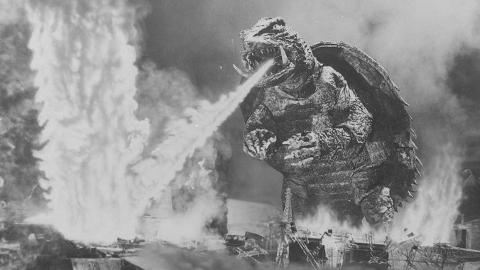
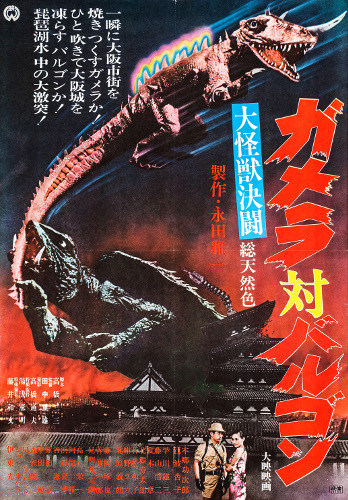
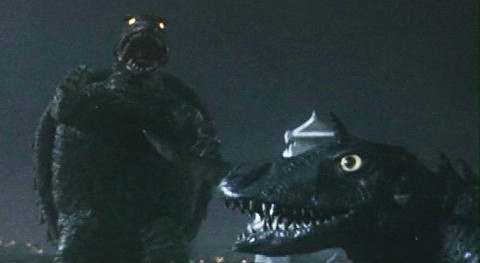
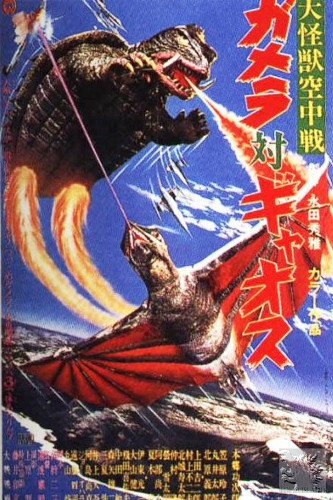
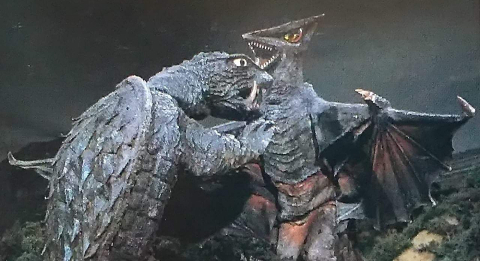
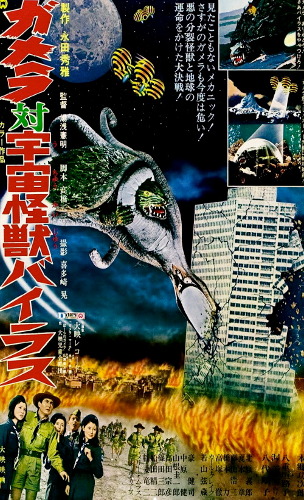

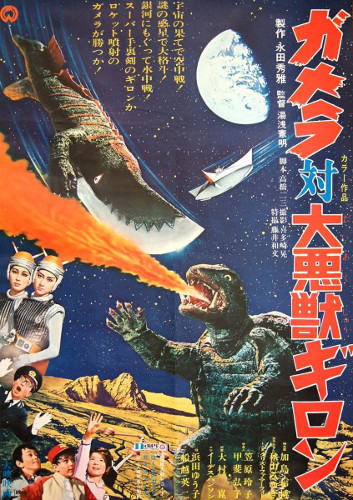
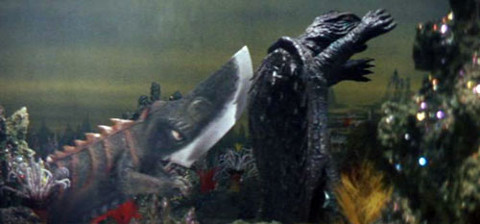
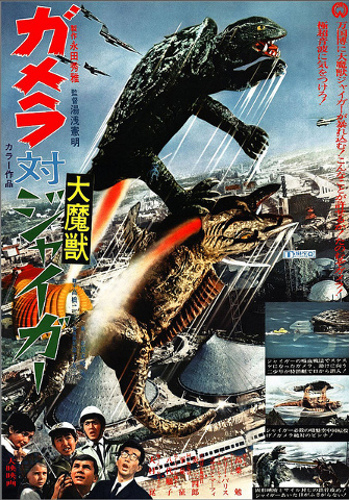
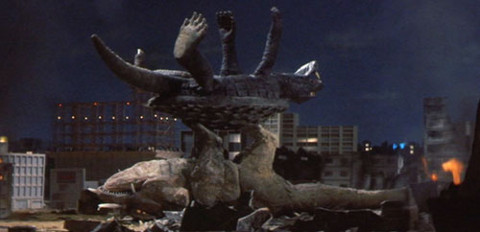
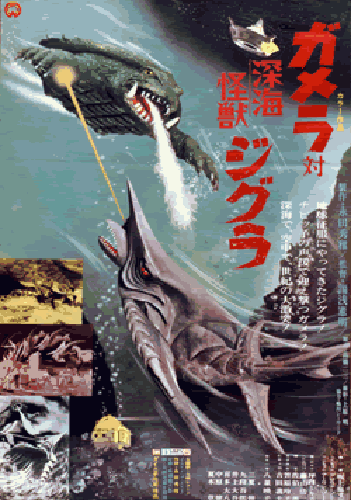

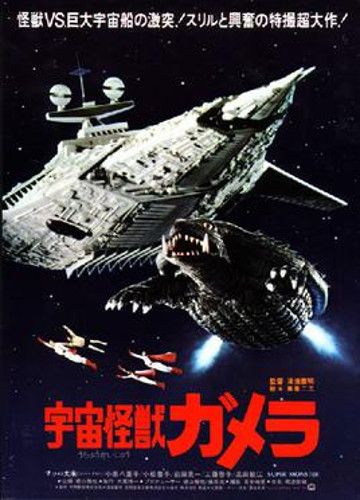


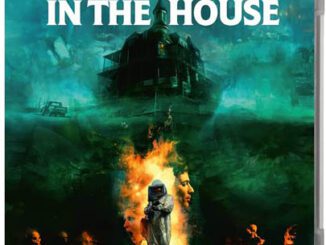

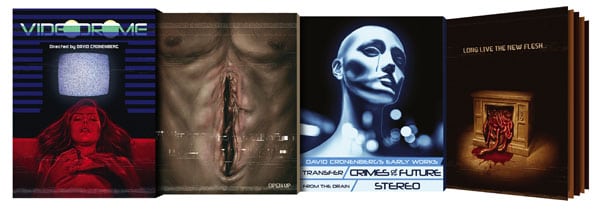
Be the first to comment